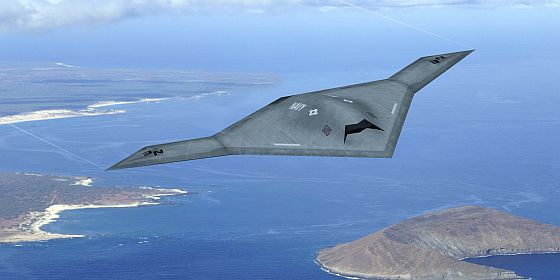Richard Parker writes: This week the Navy will launch an entirely autonomous combat drone — without a pilot on a joystick anywhere — off the deck of an aircraft carrier, the George H. W. Bush. The drone will then try to land aboard the same ship, a feat only a relatively few human pilots in the world can accomplish.
This exercise is the beginning of a new chapter in military history: autonomous drone warfare. But it is also an ominous turn in a potentially dangerous military rivalry now building between the United States and China.
The X-47B, a stealth plane nicknamed “the Robot” by Navy crews, is a big bird — 38 feet long, with a 62-foot wingspan — that flies at high subsonic speeds with a range of over 2,000 miles. But it is the technology inside the Robot that makes it a game-changer in East Asia. Its entirely computerized takeoff, flight and landing raise the possibility of dozens or hundreds of its successors engaged in combat at once.
It is also capable of withstanding radiation levels that would kill a human pilot and destroy a regular jet’s electronics: in addition to conventional bombs, successors to this test plane could be equipped to carry a high-power microwave, a device that emits a burst of radiation that would fry a tech-savvy enemy’s power grids, knocking out everything connected to it, including computer networks that connect satellites, ships and precision-guided missiles.
And these, of course, are among the key things China has invested in during its crash-course military modernization. While the United States Navy is launching an autonomous drone, the Chinese Navy is playing catch-up with piloted carrier flight. Last November the Chinese Navy landed a J-15 jet fighter on the deck of the Liaoning aircraft carrier, the country’s first carrier landing.
Though China still has miles to go in developing a carrier fleet to rival America’s, the landing demonstrates its ambitions. With nearly half a million sailors and fast approaching 1,000 vessels, its navy is by some measures already the second largest in the world.
With that new navy, Beijing seeks to project its power over a series of island chains far into the Pacific: the first extends southward from the Korean Peninsula, down the eastern shore of Taiwan, encircling the South China Sea, while the second runs southeast from Japan to the Bonin and Marshall Islands, encompassing both the Northern Mariana Islands, a United States territory, and Guam — the key American base in the western Pacific. Some unofficial Chinese military literature even refers to a third chain: the Hawaiian Islands.
To project this kind of power, China must rely not only on the quantity of its ships but also on the quality of its technology. Keeping the Americans half an ocean away requires the capability for long-range precision strikes — which, in turn, require the satellite reconnaissance, cyber warfare, encrypted communications and computer networks in which China has invested nearly $100 billion over the last decade.
Ideally for both countries, China’s efforts would create a new balance of power in the region. But to offset China’s numerical advantage and technological advances, the United States Navy is betting heavily on drones — not just the X-47B and its successors, but anti-submarine reconnaissance drones, long-range communications drones, even underwater drones. [Continue reading…]

 American precision-guided missiles launched into Pakistan’s Pashtun tribal areas aim to eliminate what are called, with marvelous imprecision, the “bad guys.” Several decades ago I, too, faced the problem of catching a notorious “bad guy” in Waziristan.
American precision-guided missiles launched into Pakistan’s Pashtun tribal areas aim to eliminate what are called, with marvelous imprecision, the “bad guys.” Several decades ago I, too, faced the problem of catching a notorious “bad guy” in Waziristan.

